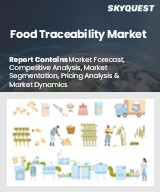
세계의 식품 이력추적 시장 규모는 2023년에 169억 2,000만 달러에 달하며, 2024년 184억 3,000만 달러에서 2032년에는 647억 2,000만 달러로 성장하며, 예측 기간(2025-2032년)의 CAGR은 11.84%로 성장할 전망입니다.
세계 식품 이력추적 시장은 기술 혁신, 유리한 규제, 진화하는 소비자 수요로 인해 강력한 성장세를 보이고 있습니다. 각국 정부는 보다 스마트한 농업을 지원하고, 공급망의 투명성을 높이며, 공중보건 성과를 개선하기 위해 강력한 식품 안전 프레임워크 구축과 추적성 기술 개발을 우선순위로 삼고 있습니다. 블록체인, IoT 지원 태그, QR코드 활용에 대한 노력이 점점 더 힘을 얻고 있으며, 전체 가공 및 물류 네트워크의 통합을 간소화하기 위해 기술 기업 간의 강력한 파트너십이 형성되고 있습니다. 이 산업은 식품 부패, 품질관리 및 부정행위 감지를 위한 예측 분석을 용이하게 하는 AI와 머신러닝의 최첨단 발전으로 변화하고 있습니다. 또한 5G의 출현은 실시간 데이터 교환을 촉진하여 식품 밸류체인 내에서 보다 민첩하고 종합적인 추적 시스템을 구축할 수 있게 될 것입니다.
Global Food Traceability Market size was valued at USD 16.92 Billion in 2023 and is poised to grow from USD 18.43 Billion in 2024 to USD 64.72 Billion by 2032, growing at a CAGR of 11.84% in the forecast period (2025-2032).
The global food traceability market is experiencing robust growth propelled by technological innovations, favorable regulations, and evolving consumer demands. Governments are increasingly prioritizing the establishment of strong food safety frameworks and the deployment of traceability technologies to support smarter agriculture, enhance supply chain transparency, and improve public health outcomes. Initiatives leveraging blockchain, IoT-enabled tags, and QR codes are gaining traction, fostering robust partnerships among tech firms to streamline integration across processing and logistics networks. The industry is being transformed by cutting-edge advancements in AI and machine learning, which facilitate predictive analytics for food spoilage, quality control, and fraud detection. Furthermore, the advent of 5G is set to propel real-time data exchange, creating more agile and comprehensive traceability systems within the food value chain.
Top-down and bottom-up approaches were used to estimate and validate the size of the Global Food Traceability market and to estimate the size of various other dependent submarkets. The research methodology used to estimate the market size includes the following details: The key players in the market were identified through secondary research, and their market shares in the respective regions were determined through primary and secondary research. This entire procedure includes the study of the annual and financial reports of the top market players and extensive interviews for key insights from industry leaders such as CEOs, VPs, directors, and marketing executives. All percentage shares split, and breakdowns were determined using secondary sources and verified through Primary sources. All possible parameters that affect the markets covered in this research study have been accounted for, viewed in extensive detail, verified through primary research, and analyzed to get the final quantitative and qualitative data.
Global Food Traceability Market Segments Analysis
The global food traceability market is segmented into technology, application, organization size, end user, and region. By technology, the market is classified into RFID, barcode, GPS, blockchain, sensors, and others. Depending on organization size, it is bifurcated into large & medium enterprises and small enterprises. According to the application, the market is divided into tracking & tracing, recall management, inventory management, and quality control. As per end user, it is categorized into retail, food manufacturing, logistics, government agencies, and food service providers. Regionally, it is analyzed across North America, Europe, Asia-Pacific, Latin America, and the Middle East & Africa.
Driver of the Global Food Traceability Market
The global food traceability market is experiencing significant growth due to heightened government regulations aimed at enhancing food safety standards. This scenario compels suppliers and manufacturers to implement advanced digital and transparent traceability systems to ensure compliance. Simultaneously, consumers are increasingly demanding detailed information regarding the origins, handling, and expiration of their food products, reflecting a more discerning approach to their dietary choices. As a result, there is a rapid uptake of innovative technologies such as blockchain, RFID, and AI-powered tracking solutions across retail, processing, and logistics sectors. This shift towards accountability within the entire value chain is propelling the adoption of traceability solutions.
Restraints in the Global Food Traceability Market
One significant challenge facing the global food traceability market is the absence of consistent protocols and guidelines across various countries and industries. This inconsistency complicates data collection and tracking processes, particularly in cross-border food trade, where seamless integration is crucial. The lack of standardized procedures hampers the effective operation of digital food ecosystems, preventing stakeholders from fully capitalizing on the potential benefits of food traceability. As a result, extensive traceability networks remain underutilized, stifling growth and innovation within the market and limiting opportunities for enhanced transparency and safety in the food supply chain.
Market Trends of the Global Food Traceability Market
The Global Food Traceability market is witnessing a significant trend towards real-time, intelligent traceability systems, driven by advancements in blockchain, Internet of Things (IoT), and artificial intelligence (AI). As companies increasingly invest in automated data logging and smart sensor technologies, the ability to monitor food quality, location, and compliance in real time is becoming paramount. This shift is largely fueled by the implementation of stricter international food safety regulations and heightened consumer demands for transparency regarding food origins and handling practices. Consequently, businesses are actively seeking innovative solutions to enhance traceability, ensuring safety and fostering trust in their supply chains.